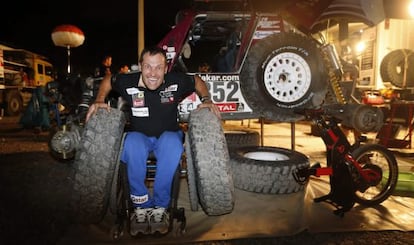“Sometimes I need more hands!”
Albert Llovera, who has been a paraplegic since he was 18, is racing in the Dakar


The list of breakdowns that he has suffered, and the ingenious solutions he has had to come up with to fix them, are right at home in a rally like the Dakar, where every stage brings its own adventures. First up the brakes failed, then the reverse gear went, and right after that it was the clutch. Albert Llovera is competing among the 108 cars taking part in this year’s Dakar Rally, and his objective is to get to the last stage, in Valparaíso. And by Tuesday, with just five days of the competition to go, he was faring well, ranked in 40th place.
The fun he is having is written all over his face, which, despite the tiredness, lights up as soon as he starts to talk about his buggy and the way that he is having to deal with the constant setbacks — none of which has anything to do with his disability.
Llovera, who was born in Andorra 47 years ago, has been a paraplegic since he was 18 after he suffered an accident skiing with the Olympic team. A year before the incident he had competed in the 1984 Winter Games in Sarajevo, but then he damaged his spinal cord. Despite the fact he was confined to a wheelchair, just a few years later he took up motorsports, and began competing on quad bikes.
These days he is one of the three official drivers for L’Ecurie du Coeur, a charitable project that aims to fund heart operations for children without resources. He accepted the offer from the Normandy team given that he would be driving a buggy, and because the team with which he competes in the World Rally Championship, Fiat, decided to turn down his Dakar project.
We got everything ready very quickly, which is why I’ve got all these problems with the car"
It wasn’t until November that Llovera found out that he would be able to compete in this year’s Dakar, giving him the chance to finish a race that he had to abandon in 2007 shortly after it began. To seal the deal for 2014 he spoke to rally driver Nasser Al-Attiyah, whom he knew from the World Championship. The Qatari supplied Llovera with what he needed, and in exchange Llovera now carries Qatar logos on his overalls and car.
“We got everything ready very quickly, which is why I’ve got all these problems with the car, as I’ve hardly been able to do any testing,” he explains. “We don’t know why still, but the car just has 25 percent of its brakes. The second day wasn’t so bad, because the stage was designed for buggies. I was going flat out! It was quite wide and so I could go at 180, and if I didn’t have brakes, I could slow down the car by drifting. My co-driver was freaking out!” he says with a chuckle.
But in the third stage, which was more mountainous, he couldn’t do the same, and had to take it slower. What’s more, he broke the reverse gear, and then later the clutch system, which had got wet. “So now I have a secondary clutch system, which works with a lever,” he explains. “Sometimes I don’t have enough hands!”
The car in which he is spending 12 hours a day has been specially adapted. It has a conventional steering wheel, as well as two slightly smaller wheels. The one on top is the accelerator, which he just has to push. The one behind is the brake. “I hold the steering wheel with two fingers, brake with the other two and accelerate with my thumb.” The system is the same that he uses in rallies, and his car even has a compartment to carry his wheelchair.
Llovera says that if he hadn’t had his skiing accident he would have competed in this race anyway, but on a motorbike. “I had a friend, Xavi Cardelús, who was a European champion in 250cc,” he explains. “One day I tried his bike and I was 1.5 seconds off his time. I really liked the sensation of racing with my knee touching the ground.”
Tu suscripción se está usando en otro dispositivo
¿Quieres añadir otro usuario a tu suscripción?
Si continúas leyendo en este dispositivo, no se podrá leer en el otro.
FlechaTu suscripción se está usando en otro dispositivo y solo puedes acceder a EL PAÍS desde un dispositivo a la vez.
Si quieres compartir tu cuenta, cambia tu suscripción a la modalidad Premium, así podrás añadir otro usuario. Cada uno accederá con su propia cuenta de email, lo que os permitirá personalizar vuestra experiencia en EL PAÍS.
¿Tienes una suscripción de empresa? Accede aquí para contratar más cuentas.
En el caso de no saber quién está usando tu cuenta, te recomendamos cambiar tu contraseña aquí.
Si decides continuar compartiendo tu cuenta, este mensaje se mostrará en tu dispositivo y en el de la otra persona que está usando tu cuenta de forma indefinida, afectando a tu experiencia de lectura. Puedes consultar aquí los términos y condiciones de la suscripción digital.
Últimas noticias
The complicated life of Francesca Albanese: A rising figure in Italy but barred from every bank by Trump’s sanctions
From digital curfews to blocking apps: How technology experts protect their children online
Why the price of coffee has skyrocketed: from Brazilian plantations to specialty coffee houses
Confined to a Cuban hospital: When electricity is a matter of life or death
Most viewed
- Pablo Escobar’s hippos: A serious environmental problem, 40 years on
- Why we lost the habit of sleeping in two segments and how that changed our sense of time
- Trump’s obsession with putting his name on everything is unprecedented in the United States
- Charles Dubouloz, mountaineering star, retires at 36 with a farewell tour inspired by Walter Bonatti
- The Florida Keys tourist paradise is besieged by immigration agents: ‘We’ve never seen anything like this’








































